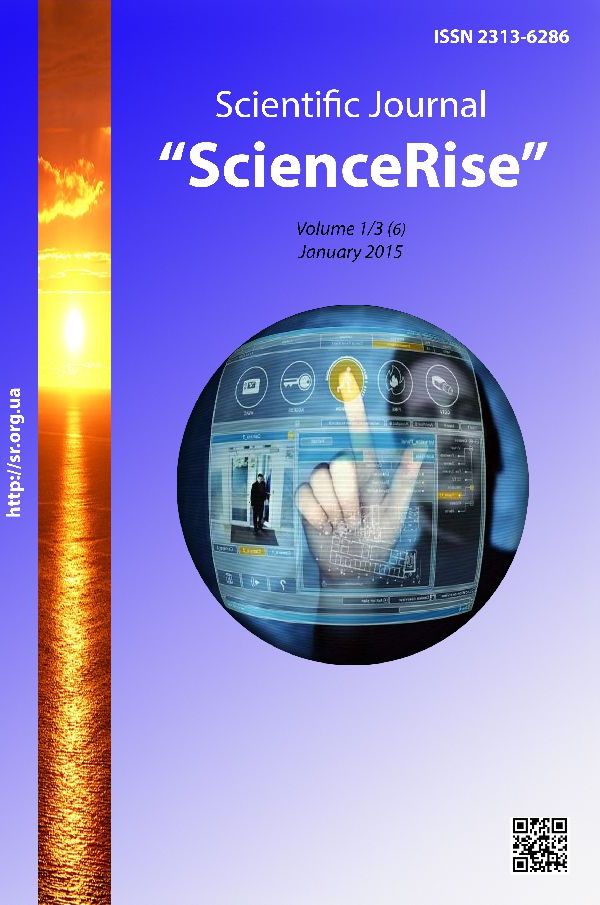Spinal anesthesia in the supine position in patients with combined trauma
DOI:
https://doi.org/10.15587/2313-8416.2015.35907Keywords:
multiple trauma, spinal anesthesia, patient position, safety, efficiencyAbstract
The method of spinal anesthesia (SA) in the supine position in patients with multiple trauma who can’t provide lateral or sitting position was proposed. The aim of the study was to compare the characteristics of the neuroaxial block and safety with traditional spinal anesthesia.
Methods. It is included 120 patients with femur or pelvis fractures: 36 - SA was performed in the supine position and 84 – in sitting or lateral positions. We evaluated the severity of pain on a visual analogue scale (VAS), comfort during manipulations, time to achieve and level of sensory and motor blocks, anesthesia duration and adverse events (AE). The Chi-square and Mann-Whitney tests were used.
Results. In both groups there was a rapid onset central unit, excellent level of anesthesia, motor block and duration of anesthesia. The incidence of clinically significant AEs (hypotension, bradycardia) groups had no statistically significant difference. In both groups all attempts spinal anesthesia were succeeded and we need more time for manipulation in supine group, but although not statistical significant.
Conclusions. Using spinal anesthesia in supine position in patients with multiple trauma can reduce the intensity of pain during manipulation. SA in the supine position on the characteristics of the neuroaxial block and safety does not differ from SA with lumbar puncture in the traditional sitting or lateral positions
References
Cousins, M. J. (1988). The spinal route of analgesia. Acta Anaesthesiol Belg, 39 (2), 71–82.
Kuchyn, I. L. (2014)ю Spinal anesthesia with low doses of local anesthetic in patients with multiple traumaю Likars'ka sprava, 3-4, 95–99.
Suslov, V. V., Fesenko, U. A., Fesenko, V. S. (2013). Spinal anaesthesia and analgesia: guidance for doctors. KH. SIM, 544.
Schultz, J. R., Njaa, M. D., Spahn, T., Auyong, D. B., Habib, A. S., Panni, M. K. (2006). Mid-calf position - an improved technique to place neuraxial anaesthesia. British Journal of Anaesthesia, 97 (4), 583–584. doi: 10.1093/bja/ael231
Jones, A. R., Carle, C., Columb, M. (2013). Effect of table tilt on ligamentum flavum length measured using ultrasonography in pregnant women. Anaesthesia, 68 (1), 27–30. doi: 10.1111/anae.12006
Imbelloni, L. E., Pitombo, P. F., Ganem, E. M. (2010). The incidence of paresthesia and neurologic complications after lower spinal thoracic puncture with cut needle compared to pencil point needle: study in 300 patients. Journal of Anesthesia & Clinical Research, 1 (2), 106. doi: 10.4172/2155-6148.1000106
Malroy, M. (2003). Local anesthesia. Transl. from English. Moscow: Binom. Laboratory knowledge, 301.
Hlumchera, F. S., Fomina, P. D., Pedatchenko, E. H., Hetmana, V. H., Roschyna, H. H. (2012). Polytravma. [Hyruhyya, travmatolohyya, Anaesthesiology Intensive therapy.] Under the editors. Kiev: TNI "Medicine", 736.
Fettes, P. D., Jansson, J. R., Wildsmith, J. A. (2009). Failed spinal anaesthesia: mechanisms, management, and prevention. British Journal of Anaesthesia, 102 (6), 739–748. doi: 10.1093/bja/aep096
Kuchyn, Y. L., Glumcher, F. S. (2013). The method of lumbar puncture in patients with unstable fractures of the femur and pelvis: a stalemate. 79190 Ukraine, IPC A 61 B 17/00. Patent Kyiv National Medical University OA Bohomoltsya. Appl. 14/11/2012; opubl.10.04.2013, Bull. №7, 4.
Downloads
Published
Issue
Section
License
Copyright (c) 2015 Юрій Леонідович Кучин

This work is licensed under a Creative Commons Attribution 4.0 International License.
Our journal abides by the Creative Commons CC BY copyright rights and permissions for open access journals.
Authors, who are published in this journal, agree to the following conditions:
1. The authors reserve the right to authorship of the work and pass the first publication right of this work to the journal under the terms of a Creative Commons CC BY, which allows others to freely distribute the published research with the obligatory reference to the authors of the original work and the first publication of the work in this journal.
2. The authors have the right to conclude separate supplement agreements that relate to non-exclusive work distribution in the form in which it has been published by the journal (for example, to upload the work to the online storage of the journal or publish it as part of a monograph), provided that the reference to the first publication of the work in this journal is included.

